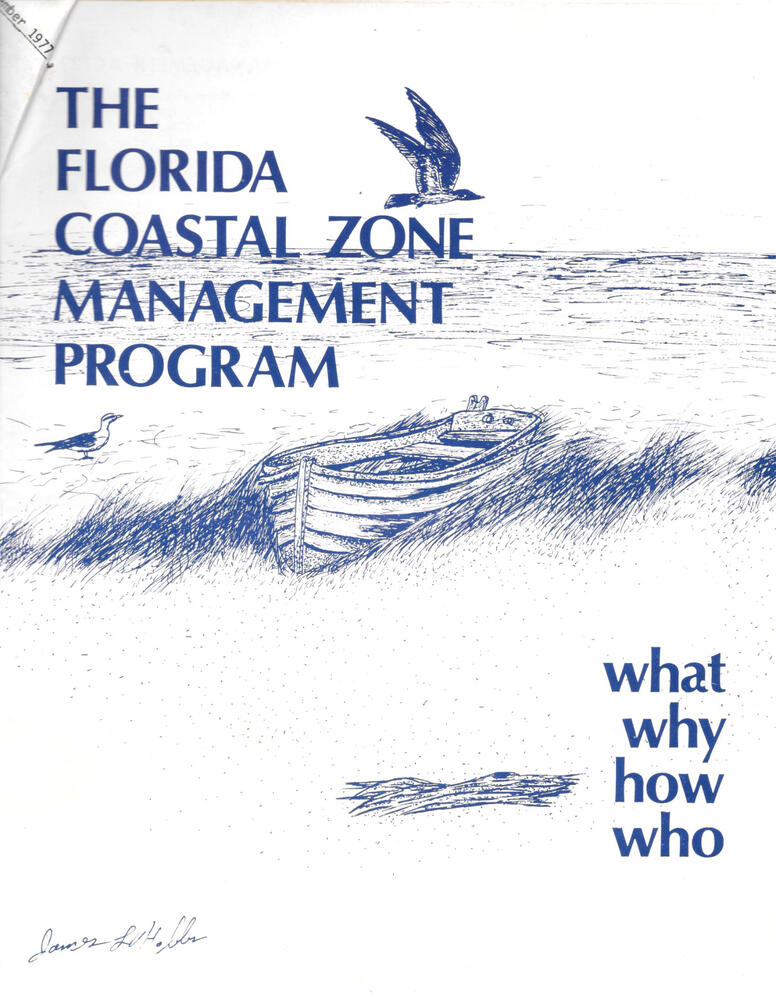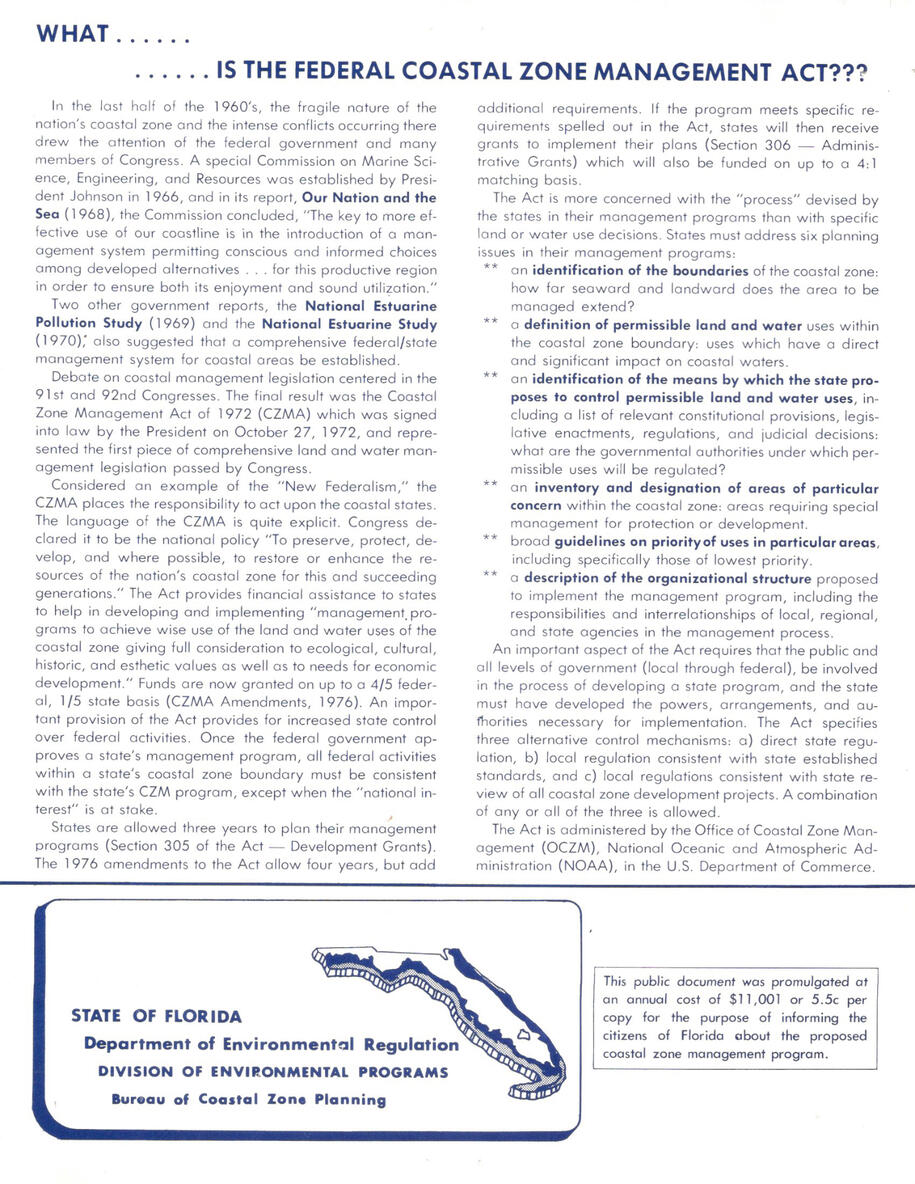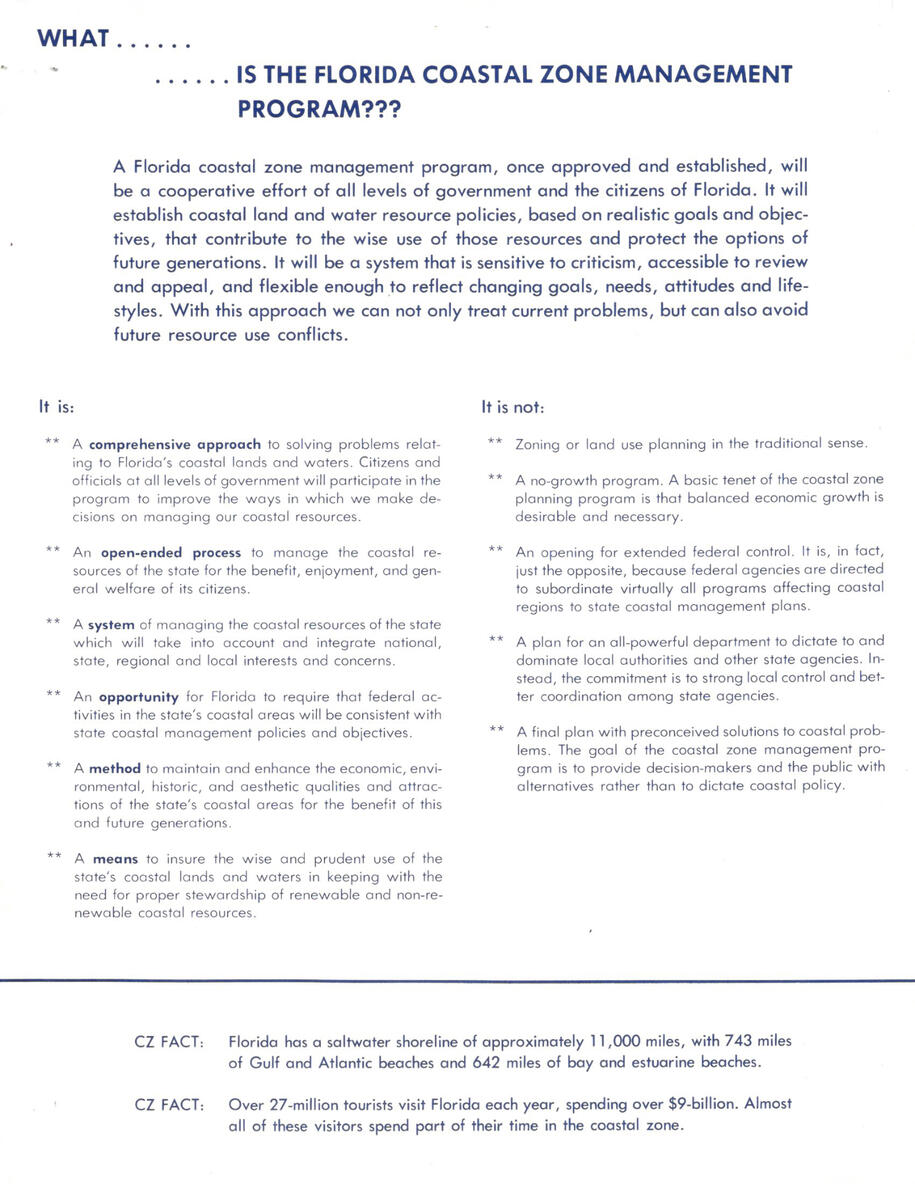
League of Women Voters Unfiled
Take a trip through the history of the League of Women's Voters
of Broward County. This blog will explore 68 years of LWF history
and advocacy, finding connections to the league's present goals.
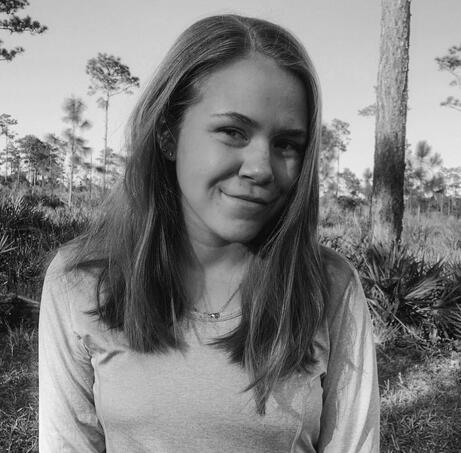
About Me
Hello! My name is Jamie Black (She/Her/Hers), and I am a student at the University of Central Florida. I am a History major, minoring in Diplomacy, and I have already completed my certificate in Judaic Studies. I will graduate from UCF Spring 2021.
This semester I am interning with the League of Women Voters of Broward County. The League of Women Voters (LWV) is a nonpartisan organization that encourages informed and active participation in government. The organization was founded nationally in 1920, six months prior to the ratification of the 19th amendment. The league is still active today and advocates for social causes but retains an unbiased stance.
Regarding my project with the LWV, I am tasked with sorting through the Broward league’s historical documents dating back to 1953. Given that the records cover 68 years of LWV history, I am still in the process of fully sorting through information and understanding everything (it is a bit overwhelming to be truthful). However, once I get a better grasp on the information, I hope to draw connections between the causes the league supported through the years, whether that be an evolution of support or a newfound support. I am very excited for my internship and I seek to gain experience with analyzing documents and relaying them to others while maintaining a nonpartisan standpoint. I believe that unbiased stance would help in my future as a public historian. I hope you will join me on my weekly journey through League of Women Voters history.
Work Cited
TBA
Weekly Blogs
Week One: January 15,2021
Week Two: January 22,2021
Week Three: January 29,2021
Week Four: February 5,2021
Week Five: February 12,2021
Week Six: February 19,2021
Week Seven: February 26,2021
Week Eight: March 5,2021
Week Nine: March 12,2021
Week Ten: March 19,2021
Week Eleven: March 26,2021
Week Twelve: April 2,2021
Week Thirteen: April 9,2021
Week Fourteen: Spring Break
Week Fifteen: April 23,2021
← Home
Week One — January 15
Hello, my name is Jamie Black! I am a student at the University of Central Florida. I am a History major, my special interest in American history and Jewish history. In addition to history, I am minoring in Diplomacy and I have already completed my certificate in Judaic Studies. I will graduate from UCF in the Spring of 2021, which I’m very excited about.
This semester I am interning with the League of Women Voters of Broward County. The League of Women Voters (LWV) is a nonpartisan organization that encourages informed and active participation in government. The organization was founded nationally in 1920, six months prior to the ratification of the 19th amendment. The league is still active today, branching out to have Leagues on a national, state, and county level. One of the key elements of the league is its advocacy for social causes, all while retaining an unbiased stance. I would say it is important to understand that some social issues are more important than political parties and their impact can go beyond party lines.
Regarding my project with the League of Women Voters, I am tasked with sorting through the Broward league’s historical documents dating back to 1953. It is quite a large project, but one that I believe is important. Given that the records cover 68 years of LWV history, I am still in the process of fully sorting through information and understanding everything (it is a bit overwhelming to be truthful). However, once I get a better grasp on the information, I hope to draw connections between the causes the league supported through the years, whether that be an evolution of support or a newfound support. Prior to starting my internship, Monica Elliott—league president—gave me history about the League of Women Voters. The history was quiet fascinating because she explained that the league started out as more of a social club situation. Yes, there was still involvement with voting and an encouragement to do so, but there were also luncheons and tea times. Today, the league is a little different and partakes in community-based events and advocacy. I hope to find some primary evidence of this switch through the documents.
Overall, I am very excited for my internship and I seek to gain experience with analyzing documents and relaying them to others while maintaining a nonpartisan standpoint. I believe that unbiased stance would help in my future as a public historian. I hope you will join me on my weekly journey through League of Women Voters history.
Week Two — January 22
This week, we are going to time travel back to the 1950s. Set your time machines for May 19, 1953 in Fort Lauderdale, Florida!
May 19th is a significant day for the League of Women Voters of Broward County, as it is was the first meeting for the Fort Lauderdale Provisional League of Women Voters (eventually changing the name to Broward County as South Florida developed). Below is a clipping of the Lauderdale Daily News from January 29, 1953 detailing the founding of the Fort Lauderdale league.
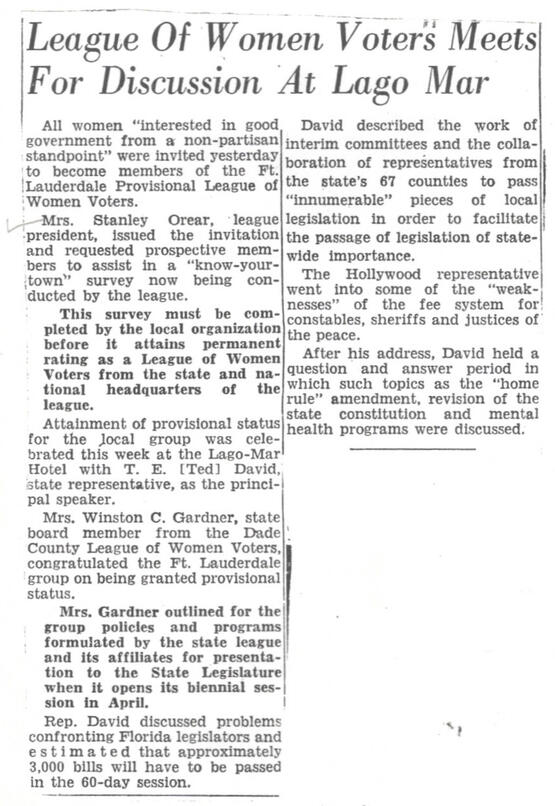
As shown, the invitations to join the league were sent out by Mrs. Stanley Orear, league president. The invitation was extended to “all women interested in good government from a non-partisan standpoint.” This piece of evidence is important because not only does it show that keeping a non-partisan stance was key in the league’s founding, but that it is also an element that has been retained over the years.
The meeting was hosted at the Lago Mar Hotel in Fort Lauderdale. Organizers expected over 200 people to attend the meeting. In the end, around 125 women showed up for tea and expressed interest in joining the Fort Lauderdale league. Anyone could join the league, man or woman, but there were requirements in terms of voting. In order to have a counting vote, a member had to be over the age of 21. As a result, students were able to have some form of a role in the league. One of the aspects I found fascinating was the league membership fee in 1953 compared to the fee in 2021. In 1953, it would cost $3 to join the league, about $32 today. With inflation considered, it costs double to join the league today with annual fees starting at $60. Shown below is the invitation to the first league meeting (left) and a photo taken of three women at the meeting from Miami Daily News (right).
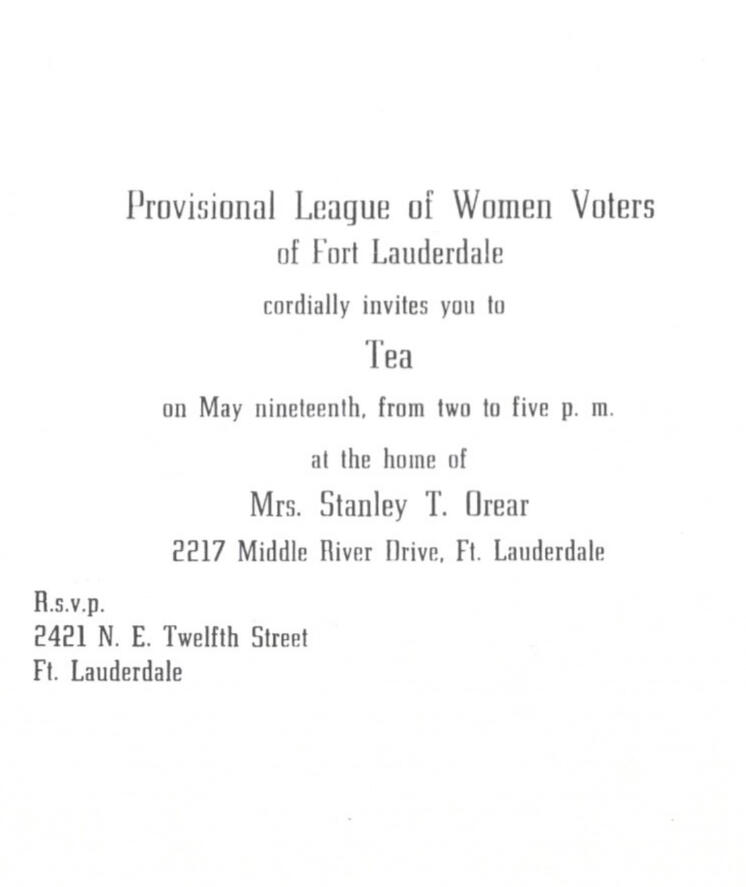
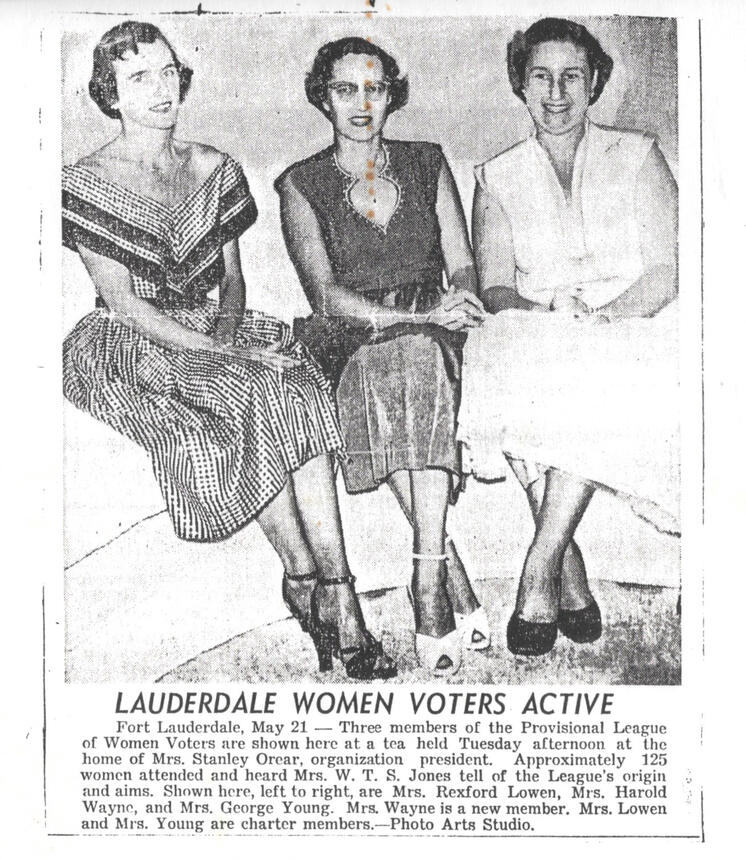
After the league was formed and given more than provisional status, women in the league began their work. Looking at the documents from the league, I found two main causes the league advocated for —economic and educational issues. In terms of economic issues, the league worked to ensure milk prices remained consistent and steady in Fort Lauderdale. While it seems like somewhat of an obscure issue to advocate for, almond milk or other milk alternatives did not exist back then, so cow's milk was an essential part of life at home. I would also argue the issue of milk is reflective of a woman’s place in the world at the time. During the time of the league’s founding, women were still at home and being a wife and mother was their job, so it makes perfect sense that they were advocating for issues that affected them in that moment and not workplace issues.
Besides economic issues, the Fort Lauderdale league helped in educational matters. In its early years before the 1960s, the league was very active in schools. The league donated constitutional kits to junior and senior high schools, aiding them in an education about the government. Additionally, the league also got in matters regarding lowering the age of school enrollment and allowing for students to stop their education once certain standards are meet. By 1959, the league became clear in establishing its overarching goals and issued statements and providing funding to promote and further voter education and study programs on public issues. Examples of this are below.
Overall, I learned a lot about the league in its beginning years and would describe it as the founding era. This era was crucial to building a framework for the league in both goals and membership. I am looking forward to learning more about the league next week during the 1960s and beyond!
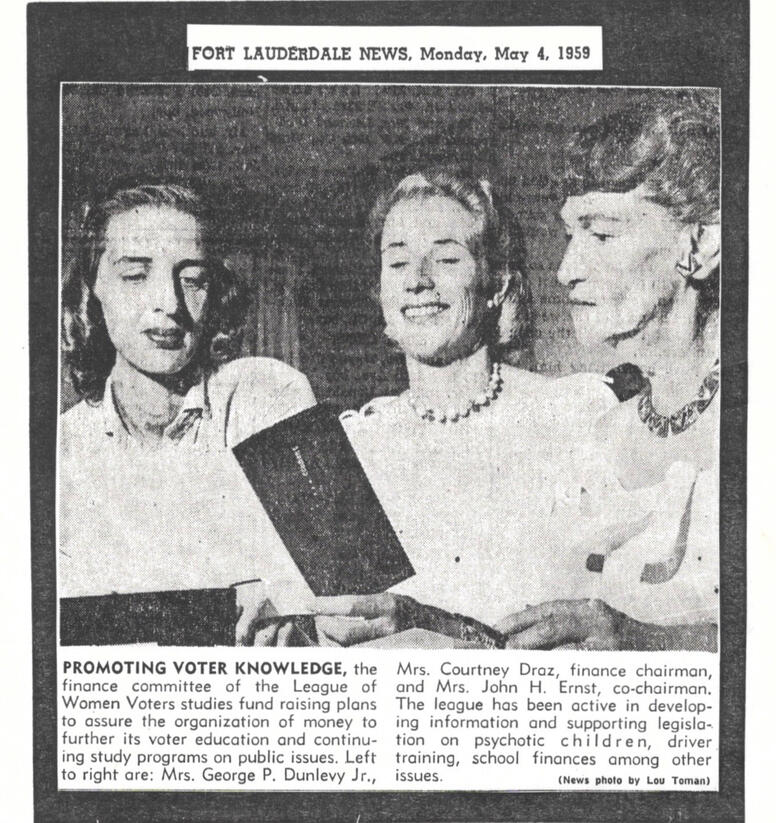
Clipping from the Fort Lauderdale News, detailing the funding boost for the league's educational programs (left). Excerpt from Good Housekeeping, defining the League of Women Voters on a national level (right).

Week Three — January 29
Diving into the records of the LWV of Broward County for the 1960s, I was interested to see the league’s community involvement. The league was heavily involved in the community, but not in the areas I would expect for the time period. The 1960s were the catalyst of the Civil Rights Movement and it would make sense that the Broward league would be involved in the movement because of its history of advocating to vote. However, this was not the case and other issues took precedence.
The dominant issues in the 1960s for the league were pollution, people with mental illness, taxes, education matters, the United Nations, and Communism. Obviously, these issues were and still are important, but they do not fully represent the community the Broward league is serving.
On the right, is a copy of a proposal from the National League of Women Voters from February 1962. The proposal highlights the agenda of the national league for 1962-64, establishing issues the league plans to support through the years. Notably missing is any mention of the Civil Rights Movement. Unfortunately, this element of the league is not something I found entirely surprising. The National League of Womens Voters was established “to further the education of all white women in citizenship and to support needed legislation.” [1] The phrase, ‘white women’, was not placed in the By-Laws of the league by accident, it was a clear means of distinguishing who would and would not be welcomed by the league. Despite this language from the By-Laws of 1925, the National league did make an effort to acknowledge the Civil Rights Movement (presumably after it gained popularity and acceptance amongst Americans).
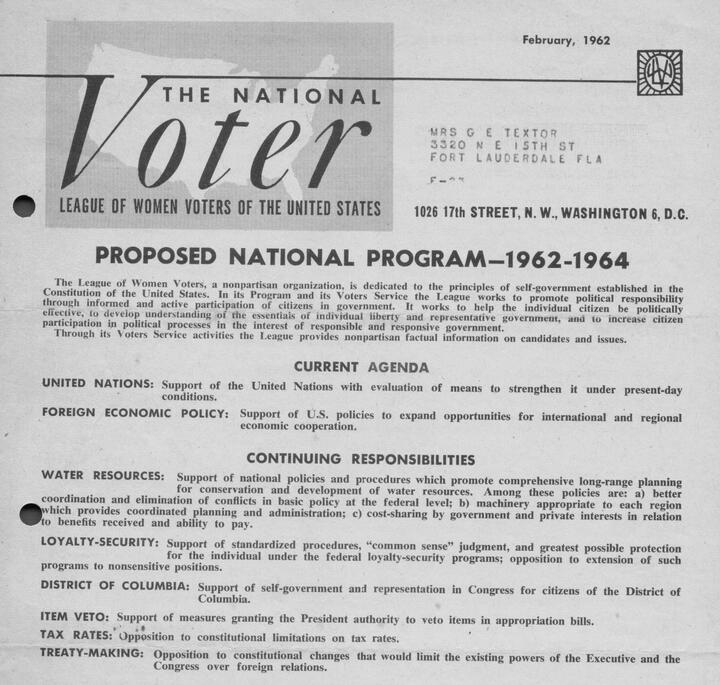
Evidence of the National League’s involvement with the Civil Rights Movements comes from sections of the Broward league’s newsletters. Displayed below are two excerpts from the newsletters, addressing the Civil Rights Movement. The national president calls the movement a “crisis on civil rights” and addresses principles the league has set forth before.
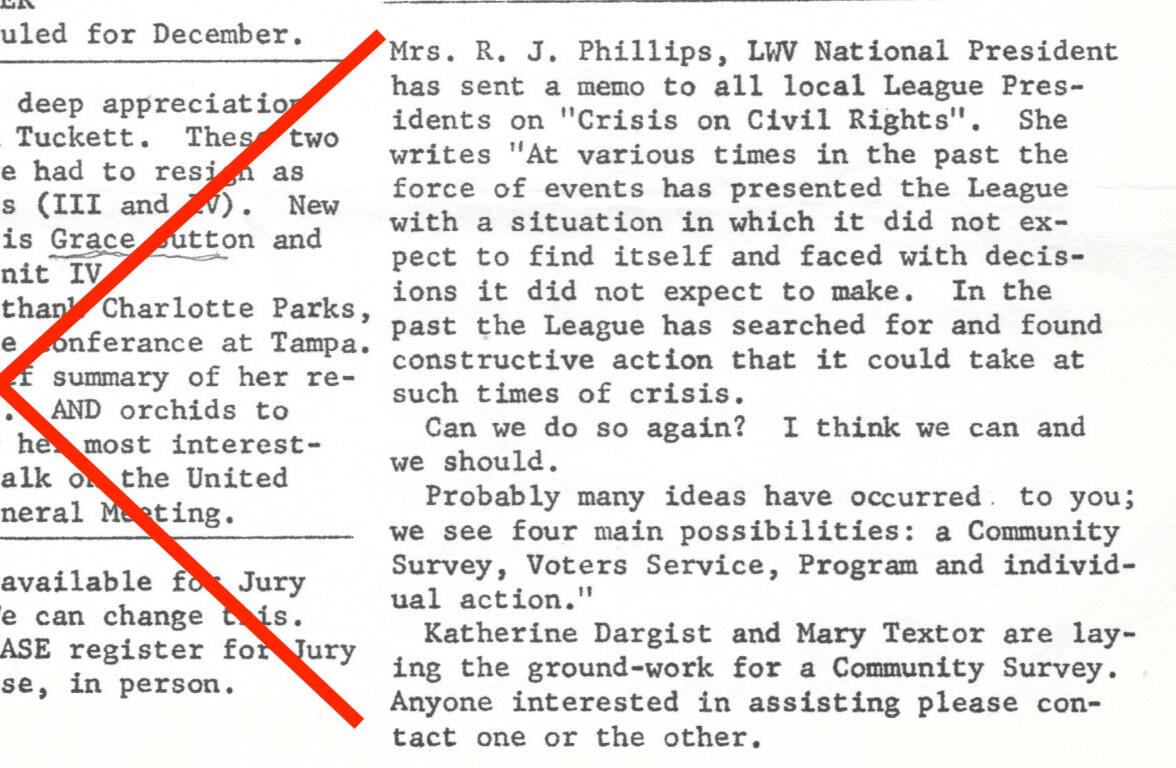
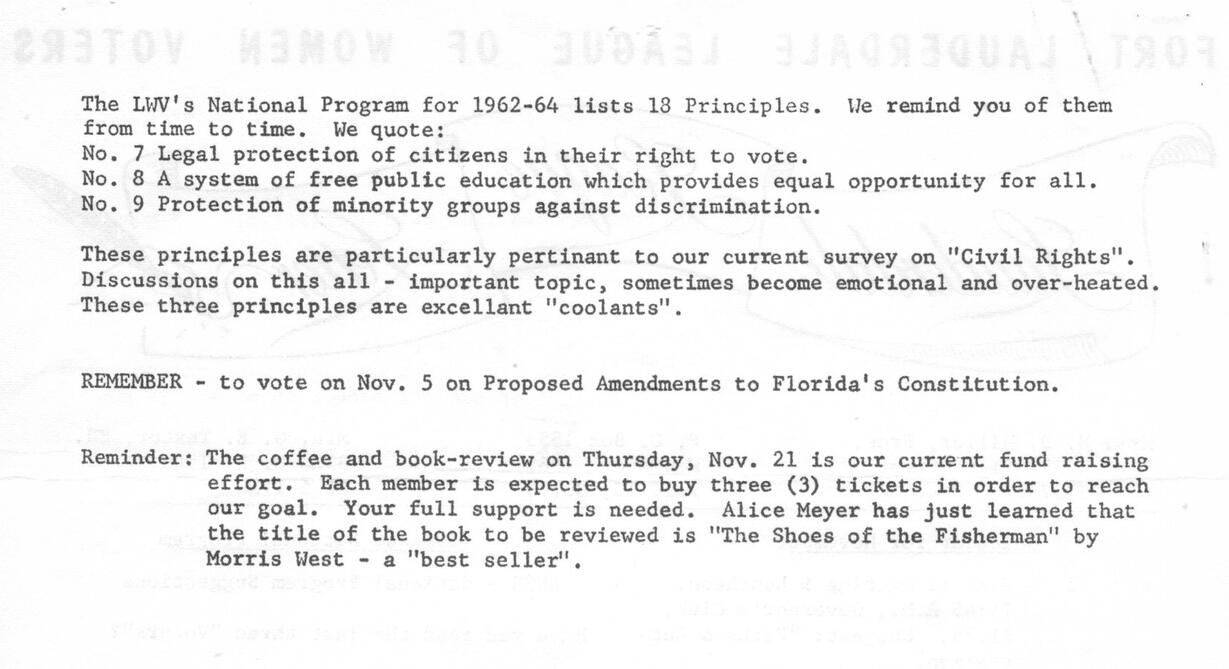
These pieces of historical evidence serve as a precursor to the passage of the Civil Rights Act of 1964 and the Voting Rights Act of 1965 for the league. Following the passage of these acts, the National league started to pursue efforts to combat discrimination. The league established a study on the Development of Human Resources out of concern there were people not living their lives with equality in America. The Broward league continued these efforts on a local level and encouraged league members to read literature by Black authors such as Simeon Booker, Harry M. Cauldill, James B. Conant, and Lewis A. Dexter. In addition to this, the league also offered its support to other people of color and the issues they were facing nationally and locally. An example of this was the cause of migrant farm workers. Nationally, the league stressed the issue of the treatment of farm workers and locally, the league worked to present laws regulating migrant labor in Florida, education of migrant children nationally, and other efforts to better the conditions for migrant workers and their families.

Overall, I found these efforts that occurred only one year after the Civil Rights Act of 1964 to be a positive movement for the league in terms of becoming more inclusive.
Following the death of Civil Rights activist Dr. Martin Luther King Jr. in 1968, the league dramatically increased their efforts. On a national level, the league expressed their joint sorrow over Dr. King’s passing. Locally, the Broward league made joint efforts to better include marginalized communities and established an Action Committee. The goals of the committee are exhibited on the left. The committee details several league sponsored projects, meant to better race relations in the local community and address other issues in the Broward community. I would argue this was an initiative that elevated Black voices in the community and probably for the first time, truly listened to those Black voices.
The ending of the 1960s was what I perceived to be the bright light for the LWV of Broward County. The league was taking steps in the right direction to be truly representative of the community. Knowing some of the league’s past and early lack of involvement with the Civil Rights Movement, I did not have hope that things would change, but the league proved me wrong. I look forward to exploring the league’s further efforts in the 1970s and onward, hopeful that this inclusive attitude was maintained.
[1] Carver, Joan S. "First League of Women Voters in Florida: Its Troubled History." The Florida Historical Quarterly 63, no. 4 (1985): 383-405. Accessed January 28, 2021. http://www.jstor.org/stable/30152979.
Week Four — February 5
It is time to celebrate! It is the 50th anniversary of the ratification of the 19th amendment, at least it was in 1970. The 19th amendment to the US Constitution gave (white) women the right to vote, so it is obviously a big deal for the League of Women Voters. This week, I will explore the league’s documents from 1970-72, shortening my range of observation because of an influx of LWV issues and documentation.
While the league was celebrating the fiftieth anniversary in 1970, it was also still in action. In the year of 1970, the league focused on several issues ranging from foreign relations to more local issues. In 1970, the Cold War was persisting and as result, the league continued to take stances on the war. One of the interesting things in terms of their foreign relations stance was the shift in interest from Russia to China. This shift can be attributed to the lessening of the USSR’s strength, following Joseph Stalin’s death, and communism’s spread in Asia. Unsurprisingly, the league supported the United States and took a stance against China. On the local level, the league’s dominant focus was migrants, education, welfare, and environmental pollution. It is important to note that these issues continued through the seventies and well into 1972.
Within Broward County is the city of Pompano Beach, an area that was popular for farm work in 1970. Those farm workers were primarily migrants and lived with their families in Pompano Beach. The Broward league, with a history of advocating for migrant workers and families in Florida, focused their efforts on Markham Elementary School. The school’s migrant children demographic was ninety percent and termed an experimental school because of its population and its education programs relation to industrial arts, home and family, and instrumental music. The Broward league’s efforts to assist Markham Elementary School is documented below. Being a Broward resident, I did a little extra research on the school and learned it still exists in 2021, but today the school's population is 60% Black and 37% Hispanic. I thought that little fact was interesting and very representative of how community demographics can change rather quickly through the decades.
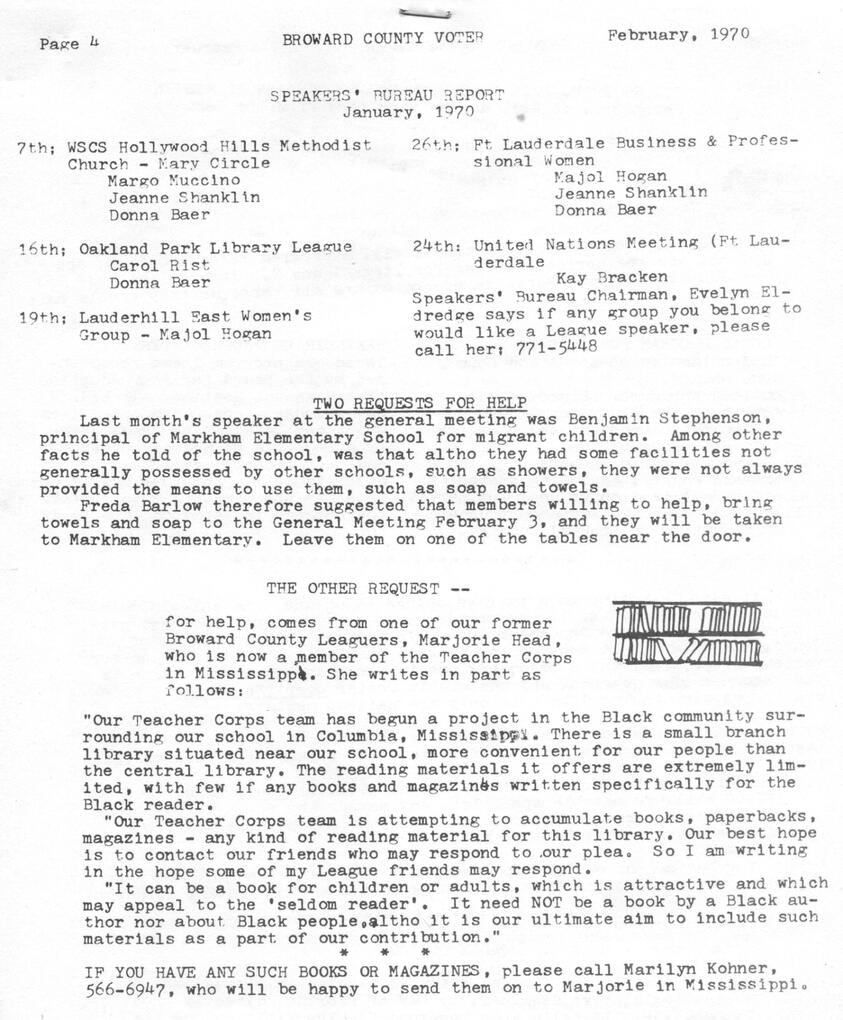
Between 1970-72, the Broward league focused on environmental issues just as they did before. However, I would argue the league became more heavily involved in the environment and pollution matters based on their increased publications about the subject. The league developed a study on air and water pollution in order to create a league stance on the issue. The study brought forward questions regarding policy and procedure, regulation, and financing. Overall, on the matter of pollution, the league encouraged better habits at home through its newsletter publications.
Additionally, the league focused on welfare and busing in the specified years. Both issues were very spoken about, so the league took a stance. Regarding busing, the Broward league took a position in favor of busing. As result of this stance, the league condemned the busing moratorium proposed by President Nixon. On the matter of welfare, the league stated that it is the federal government who should take most of the responsibility for providing income assistance. The league emphasized assistance programs such as childcare, counseling, family planning, and health and legal services. These two social issues were a dominant aspect of Nixon’s administration, so the league’s commitment to them is expected. Yet, the league yet again went further and looked to see improvements that could occur on a district level.
Starting in the early seventies, the league turned its attention to public libraries. The league launched several studies on the matter, ranging from accessibility to libraries and the county’s efforts in supporting libraries. The league found that much more needed to be done by the county, public libraries not existing in Broward on a county level prior to 1970. The league advocated for the development of libraries, their fight for the creation of more public libraries continuing into next week’s blog. See you then!
Week Five — February 12
In last week’s blog post, I discussed various subjects and highlighted the League of Women Voters of Broward’s efforts in the community during the early 1970s. One of these efforts involved the league's goal of establishing a county library system, and that continued into the years we will discuss this week—1974 to 1976.
Prior to 1974, the Broward league was working to establish the county library, but more progress occurred in these later years. The league worked in combination with Stephen L. Whitney, the new library director, to see the progress of the league’s goal. The county wide program was allotted a $1.5 million budget, giving it plenty of room to grow. In its efforts to establish a county wide library, the league explained funding measures to the league members to help grow support but also ensure they were fully educated on the matter. Being an informed individual was a key element of the League as a whole, so it makes sense that further information and consensus was provided. While the county library was an important goal of the league, national matters seemed to overshadow this goal.
On a national level, the League of Women Voters took interest in the Equal Rights Amendment or ERA. The ERA was originally drafted in 1923 by Alice Paul and Crystal Eastman, and its goal was to ensure equal legal rights to all Americans regardless of sex. By the 1970s, the amendment gained popularity again and in 1972 was approved by the US Congress. Following the approval, Congress sent the proposed amendment to each state and included a seven-year ratification deadline. [2] With this, the Broward league focused on getting the state of Florida to pass the ERA. The league organized many efforts to help with the passage of the amendment, unfortunately they saw no results.
While the ratification of the amendment has not occurred in Florida to this day, the league’s efforts are commendable. One of the big things I noticed about the league advocating for the ERA was their emphasis on how things would not have a dramatic change, and if anything, it would be a positive change. One might think, ‘wouldn’t a dramatic change be what the league wanted?’ which would not be wrong to think, but context is also necessary. By not characterizing the amendment was a dramatic measure and change, the league was able to reach more people. Opponents of the ERA believed the amendment would change the gender roles in America, roles that some women (and men) wanted to maintain. So, the Broward league made a broad appeal, explaining the amendment would only apply in terms of government action and not private or social action between men and women. Additionally, the league explained the ERA was not to be feared and referenced former President Eisenhower who regarded the amendment as “a matter of simple justice.” Efforts of the league are displayed below, their methods to attempt the passage of the Equal Rights Amendment varying.
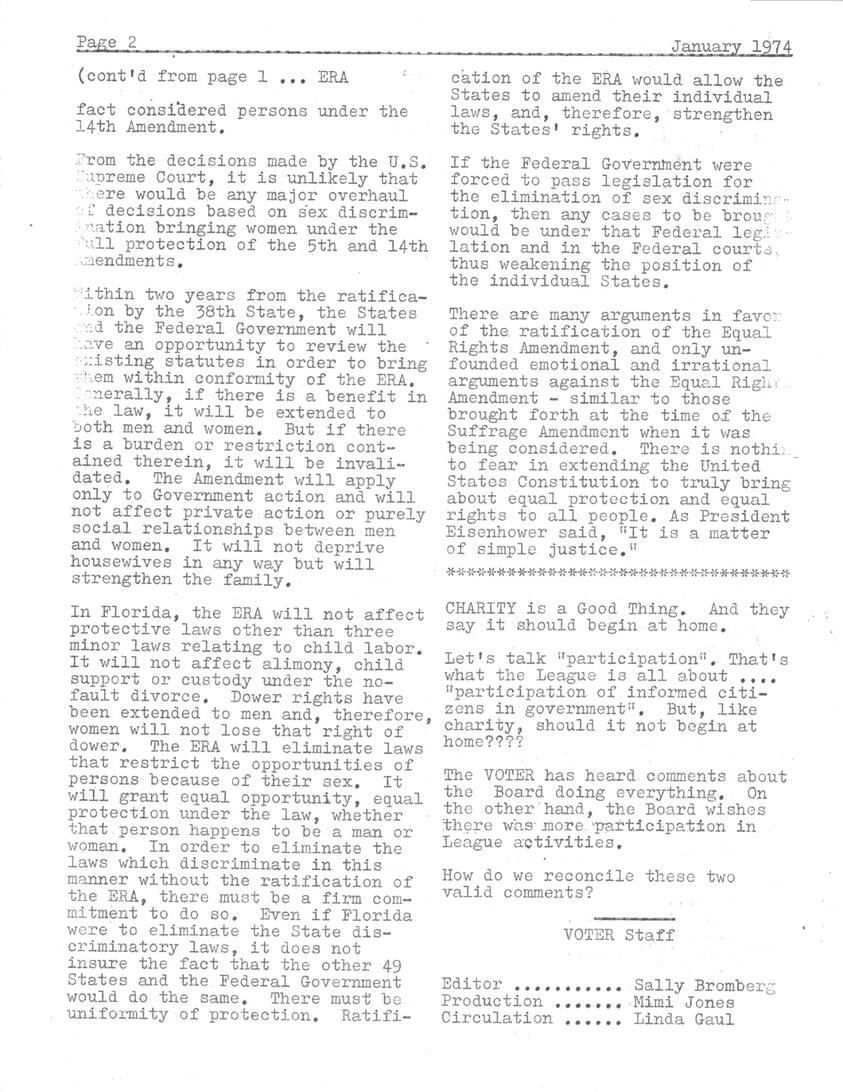
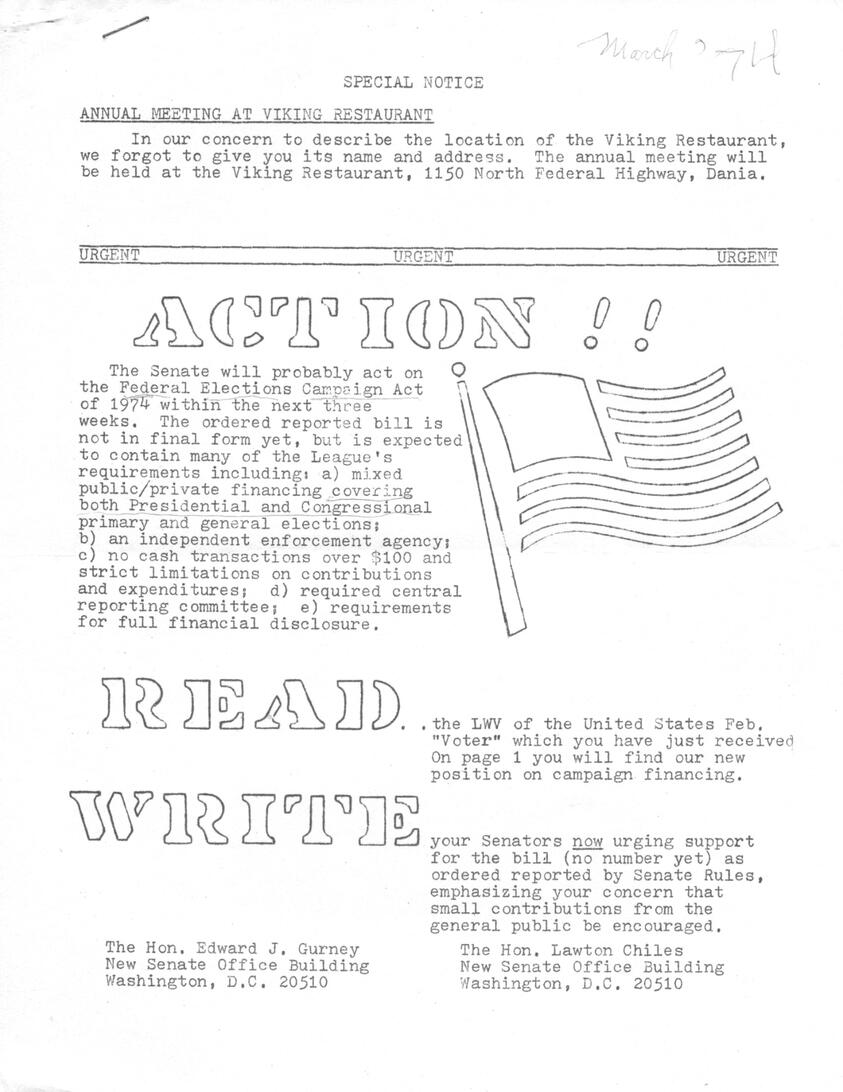

The league’s efforts, despite the ERA not being passed, should be held with high regard. The league went against the status quo of the time, challenging gender norms and concepts like the nuclear family. Altogether, I found the Broward league’s involvement with the ERA to be so interesting, especially their means to try and appeal to all audiences. I would say the previous broad appeal is something the league could build off today, or any advocacy group for that matter. The attempted ratification of the Equal Rights Amendment in the 1970s is a lesson, one that is important in history.
[2] "The Equal Rights Amendment Explained." Brennan Center for Justice. October 09, 2019. https://www.brennancenter.org/our-work/research-reports/equal-rights-amendment-explained.
Week Six — February 19
After last week's blog covering the League of Women Voters of Broward and their involvement in the Equal Rights Amendment, I could not help but feel like I was failing to cover the league’s involvement in the 1970s with other major issues. While the ERA was obviously an important issue for the league, they still covered a variety of subject issues at the same time. I would broadly categorize these issues into two umbrellas—the environment and justice for underrepresented communities.
Under the category of the environment, the Broward league sought multiple avenues of bettering the environment. One of these avenues was land use decisions. These decisions were often made by the federal and local government, but the public did have a say hence the league’s involvement. The league however questioned who should be involved in making land use decisions and issues publications on the matter. This publication is featured below.
Besides debating who should make decisions regarding land use, the league reached a consensus on the issue. This consensus contained a suggestion of land use planning, countering land exploitation, redefining owner's property rights, redevelopment and improvement of land in use already, and more. This consensus helped the league to achieve a united stance and better odds of protecting the environment. The league believed the protection of land aided in the protection of the environment.
Other league efforts involving the environment were very direct, suggesting mass transportation to reduce pollution and environmental programs. On the subject of mass transportation, the league had multiple speakers at their meetings to try and find a way to form a mass transit system that was an economical method of transport, but also environmentally conscious. The league stated its goal was to save fuel, cut traffic, and reduce pollution. The league also supported The Florida Coastal Zone Management Program in 1977 and issued flyers about the program in its monthly newsletters. The program was created by the state of Florida under the Department of Environmental Regulations. As mentioned in the programs name, the goal was to protect the Florida Coastal Zone. Given that this was an environmental issue that would have impacted those on the coast in Broward, it is clear why the Broward League was in support of the program and the measures it suggested. Click here to see the document published by the Florida Coastal Zone Management Program.

A commitment to the environment was a key goal of the league in the 1970s, but the league also put efforts in justice for underrepresented communities. One of the underrepresented communities the league advocated for were farm workers. Efforts to help farm workers prior to the 70s were discussed in previous blogs, showing the leagues dedication to farm workers. In its newsletters, the league highlights its growth within their committee for human resources, which covers farm workers, this growth representing the magnitude of the issue. The league was consistent in its efforts to help farm workers in Florida. Additionally, the league explored a new subject in the 1970s—the administration of justice. The league did cover a range of issues regarding the administration of justice, but their key issue was juveniles. In this period, there was debate about the treatment of juveniles and how they should be treated in the justice system. This debate is pictured in the documents below from the Broward league. I will leave this week’s blog post here, opting for food for thought and reflections on the criminal system through the years.
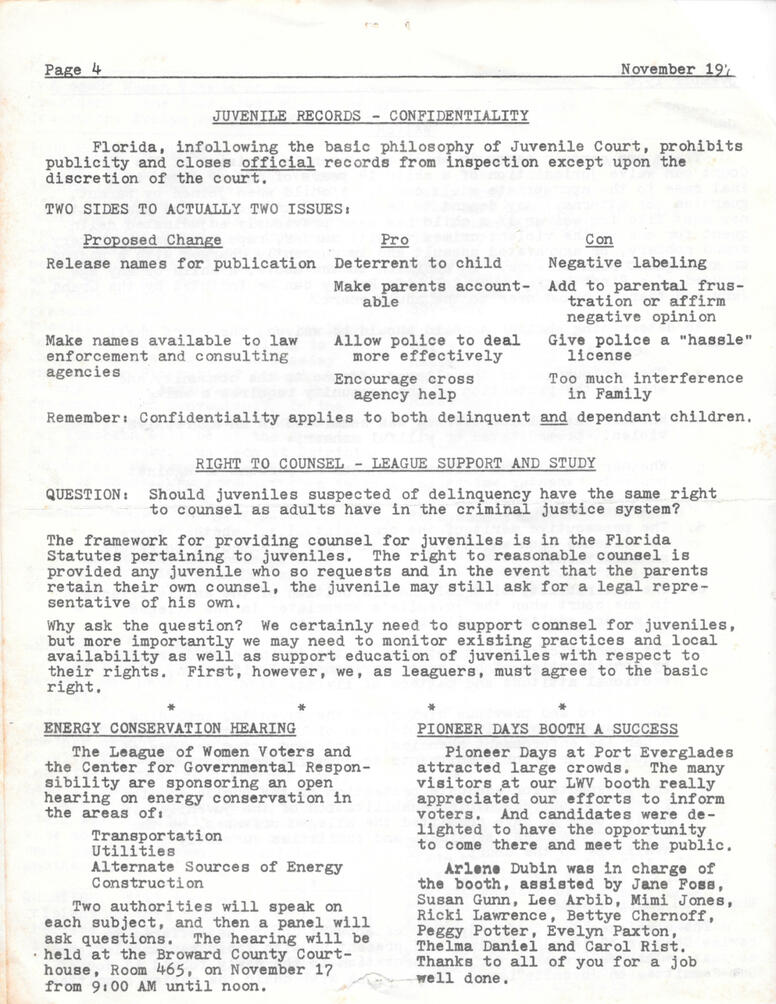

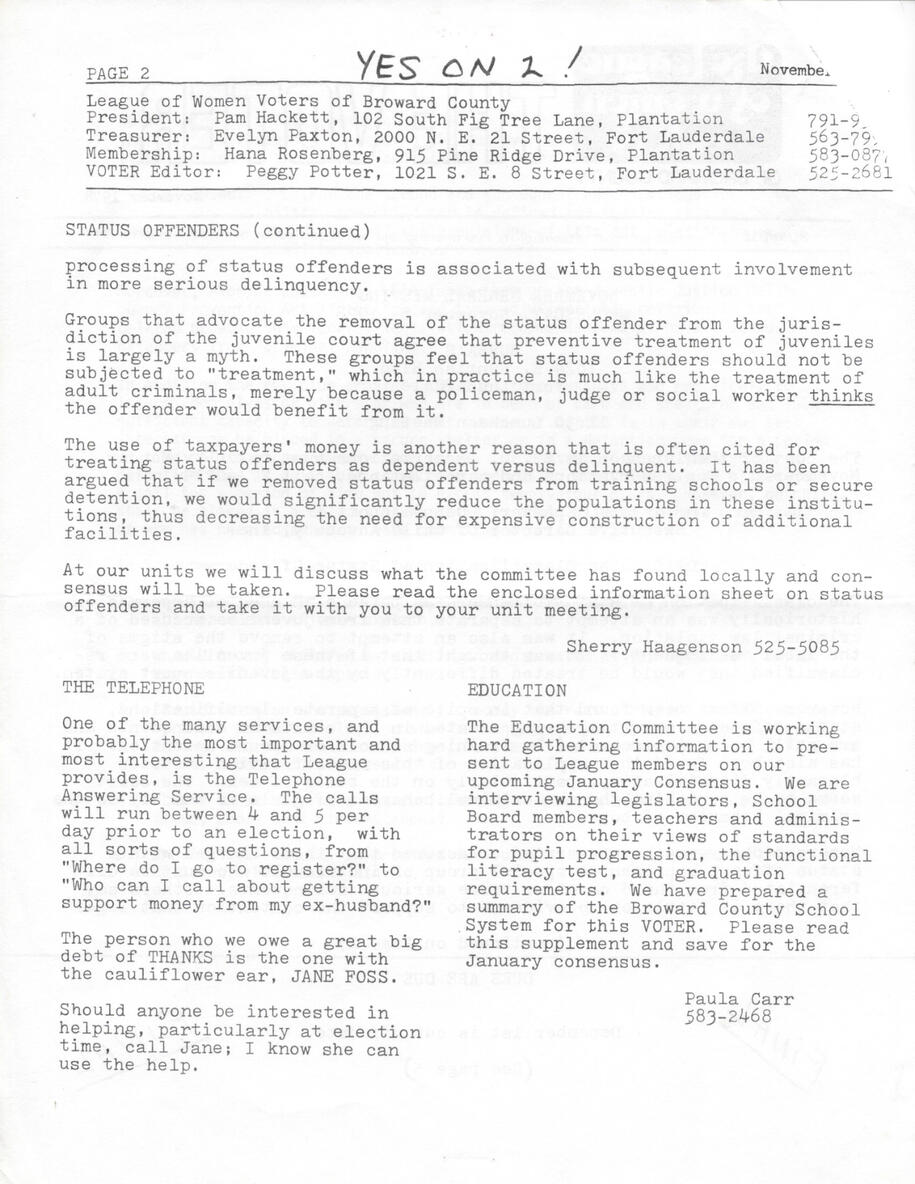
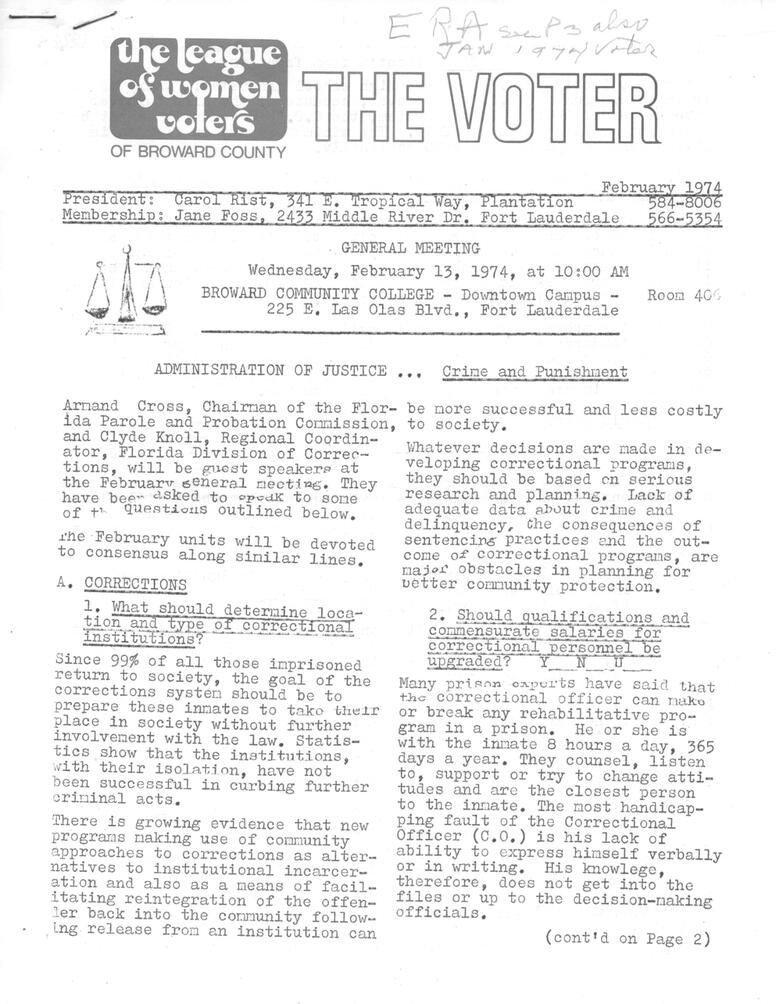
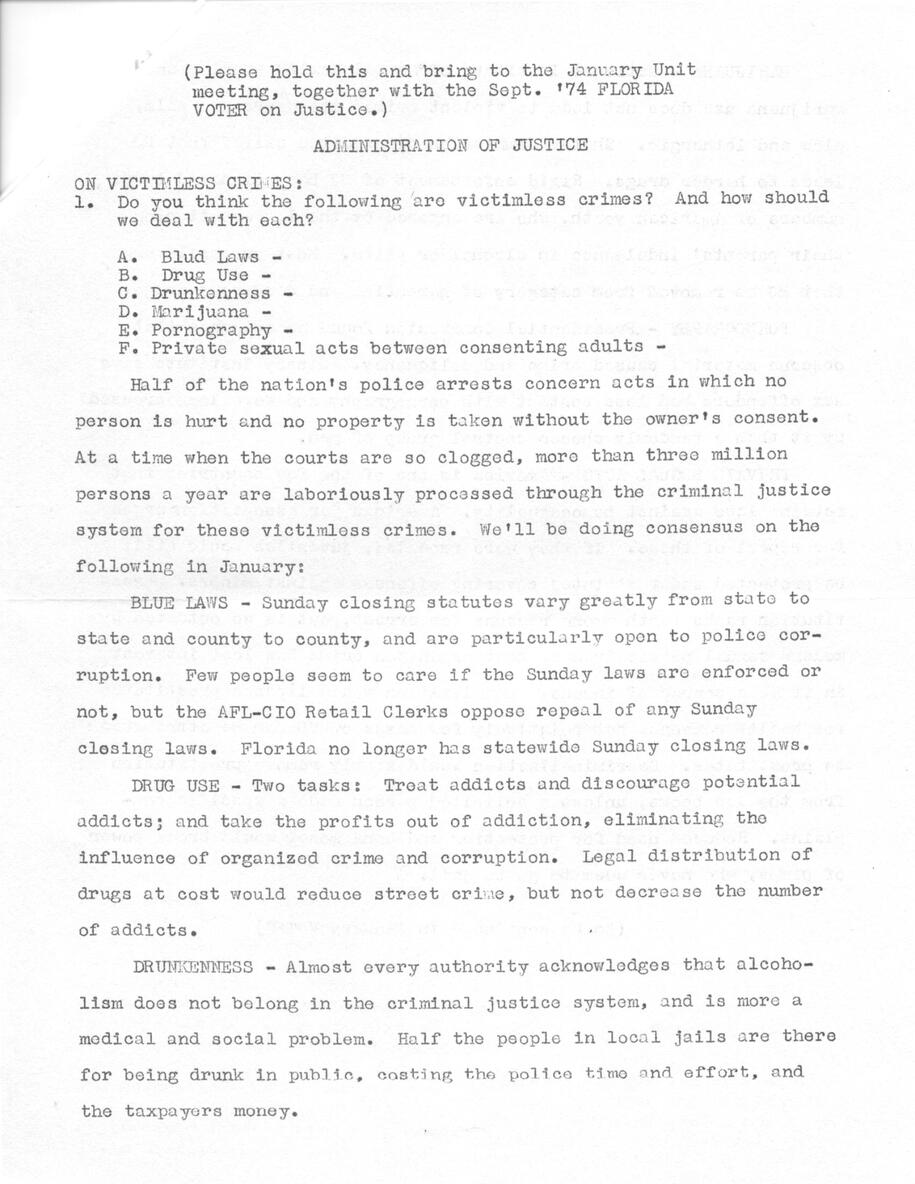
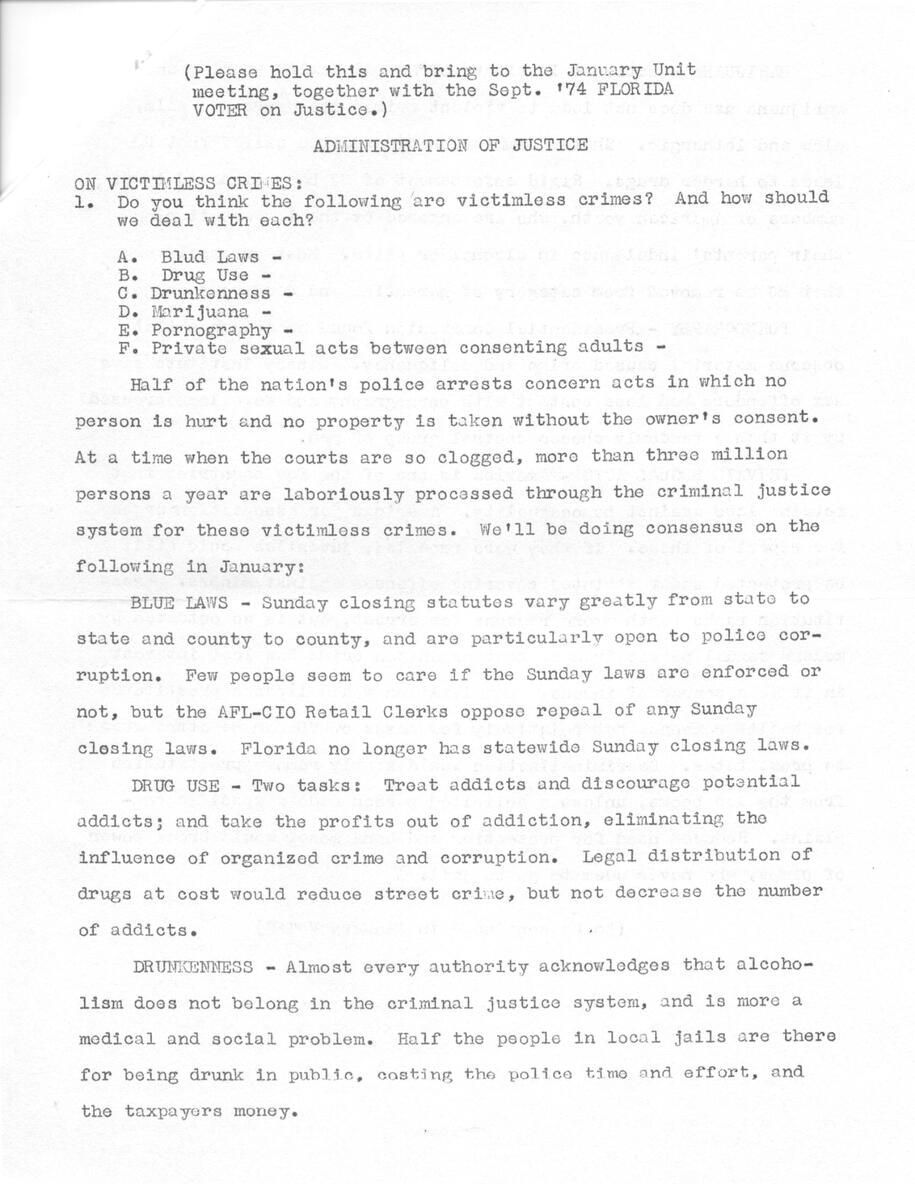
Florida Coastal Zone Management Program Publication
